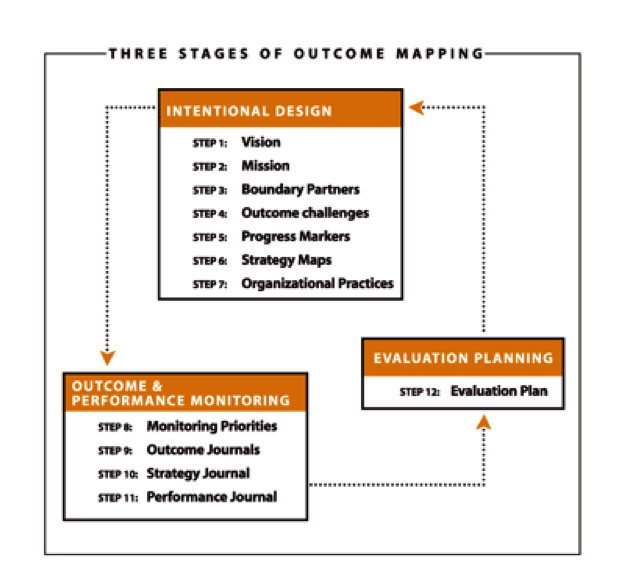We are Kaia Ambrose of CARE Canada and Simon Hearn of the Overseas Development Institute, UK and we’ll be facilitating a professional development workshop at this year’s AEA Conference to introduce Outcome Mapping (OM). We’d like to share with you our whistle-stop-tour of OM and how it can add value to your evaluations, drawing on our practical experiences with this method and our involvement in the Outcome Mapping Learning Community.

OM is a well-established approach to planning, monitoring and evaluation in the international development sector but has also been applied in developed country contexts. It was developed by the International Development Research Centre to support embedding learning and evaluative thinking into the design and implementation of complex interventions. In this way it fits well into the developmental evaluation approach and has been used alongside this approach a number of times.
Drawing on principles of OM, we offer four tips for evaluating complex interventions:
1) Focus on the actors that matter
When developing a logic model for either planning or evaluation, put people and their inter-relationships at the heart. OM draws on systems thinking to define the ‘boundary partners’ who are critical for the development and sustainability of the system as a whole and helps to works through how to support them.
2) Define your sphere of influence
No matter how hard we try, we have very little control over how or if social change happens, and we certainly can’t be exclusively attributable to that change. But we do have influence. OM helps to focus our interventions on those actors that we can effectively support and influence their pathways of change – and therefore develop realistic expectations of results.
3) Prioritise behavioural change outcomes
Sustainable well-being depends on human behaviour. Whatever change we are looking for in the world it will always come back to behaviour. OM monitors and evaluates changes in behaviour, actions, interactions and relationships of key actors and helps to understand the complexity of behaviour change by breaking it down into progressive, observable steps.
4) Look for contribution rather than attribution
Social change is non-linear, cumulative, dynamic, multi-directional, emergent, and is a product of what many people do (or don’t do). It is therefore unhelpful to talk in terms of attribution of results. Thus OM seeks to understand the contribution of an intervention in the context of many of other influencing factors.
Rad Resources:
The Outcome Mapping manual (free download)
Video introduction to OM (20 mins)
Video case study of OM use in Madagascar (20 mins)
This week, we’re featuring posts by people who will be presenting Professional Development workshops at Evaluation 2013 in Washington, DC. Click here for a complete listing of Professional Development workshops offered at Evaluation 2013. Do you have questions, concerns, kudos, or content to extend this aea365 contribution? Please add them in the comments section for this post on the aea365 webpage so that we may enrich our community of practice. Would you like to submit an aea365 Tip? Please send a note of interest to aea365@eval.org. aea365 is sponsored by the American Evaluation Association and provides a Tip-a-Day by and for evaluators.

Pingback: Outcome Mapping: Considering Complexity, Relationships, and Context in M&E for Social Change | Katherine Haugh's Blog